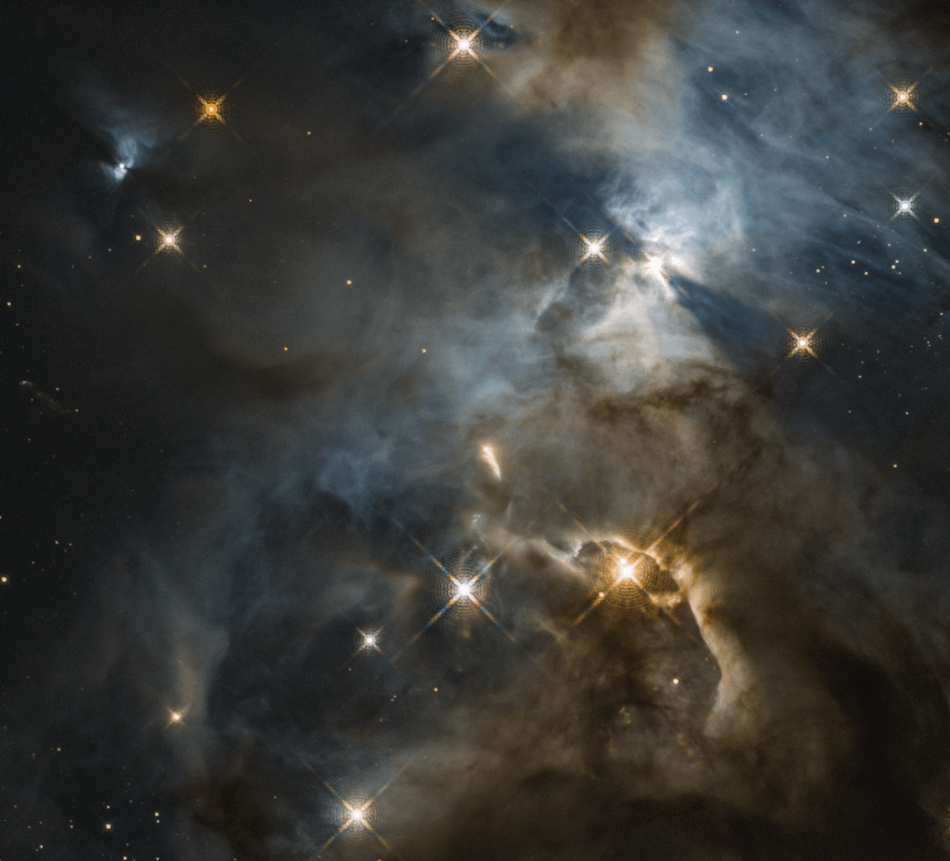Nov 1 2018
On Earth, shadows could be a premonition or they can be mysterious. However, in space, they can offer information that is otherwise not known. In a stellar nursery named Serpens Nebula, almost 1300 light-years away, the shadow game of a young star has been unraveling mysteries of its hidden planet-forming disk. The shadow, formed as a result of blocking of the fledgling star’s brilliant light by this disk, was captured by the near-infrared vision of NASA’s Hubble Space Telescope.
 In this Hubble image, the feature nicknamed the “Bat Shadow” is visible in the upper right portion of the picture. A similar shadow is seen at upper left. (Image credit: NASA, ESA, and STScI)
In this Hubble image, the feature nicknamed the “Bat Shadow” is visible in the upper right portion of the picture. A similar shadow is seen at upper left. (Image credit: NASA, ESA, and STScI)
A debris ring of dust, ice, and rock surrounds this Sun-like star, named HBC 672. This ring is a disk that is too distant and too small to be observed, even by Hubble. However, similar to a little fly that strays into the beam of a flashlight shining on a wall, its shadow is largely projected onto the cloud in which it originated.
In this Hubble image, the span of the feature—named the “Bat Shadow”—is roughly 200 times the length of the solar system. It can be seen in the upper right portion of the image.
“This is an analog of what the solar system looked like when it was only 1 or 2 million years old,” explains Klaus Pontoppidan, an astronomer at the Space Telescope Science Institute (STScI) in Baltimore, Maryland. “For all we know, the solar system once created a shadow like this.”
The occurrence of a shadow suggests that the disk is being observed almost edge-on. This fact could not otherwise be noted due to the great distance of the disk from Earth, rendering it too small to be observed by Hubble.
The shadow of the disk is analogous to that produced by a cylindrical lampshade. Although light escapes from the top and bottom of the shade, along its circumference, dark cones of shadow are formed. The disk that causes the shadow to be formed is a common object around young stars, but the combination of an edge-on viewing angle and the surrounding nebula is unique.
The shadow can be used by researchers to recognize the disk’s shape. For instance, now it is known that the disk is puffy, indicating that it is completely filled with gas. Although a major portion of the shadow is totally opaque, researchers can search for color differences along its edges, where some light enters. The color and shape of the shadow can be used to determine the size and composition of dust grains contained in the disk.
“These shadows are not easily seen in visible light, but the stellar disks and the shadows they project onto the surrounding nebula can be easily detected in infrared light,” stated Max Mutchler, a research and instrument scientist at STScI. “This infrared Bat Shadow reveals properties of both the small, dusty disk and the much larger nebula.”
The shadow is an example of phenomena that the James Webb Space Telescope will be able to analyze in even greater depth in the future. “Webb’s power lies in its ability to see into the dust and gas of these disks to understand the material that comprises these environments that form planets,” explains scientist Alexandra Lockwood of STScI.
A look-alike shadow phenomenon emerges from another young star, at the upper left of the Hubble picture. What seems to be a void, at the lower right, is probably a part of a foreground cloud. This cloud partially blocks the light from the red, double star inside the void.
The picture will be used with NASA’s Universe of Learning to demonstrate the way shadows can offer information about phenomena that cannot be observed. This program involves creating materials and experiences to allow learners to explore the universe for themselves. NASA’s Universe of Learning materials are based on study supported by NASA under award number NNX16AC65A.
The Hubble Space Telescope is a project of international cooperation between NASA and ESA (European Space Agency). The telescope is managed by NASA’s Goddard Space Flight Center in Greenbelt, Maryland. Hubble science operations are conducted by the Space Telescope Science Institute (STScI) in Baltimore, Maryland. The Association of Universities for Research in Astronomy, in Washington, D.C. operated STScI for NASA.